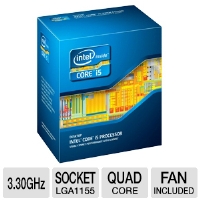 In January 2011, Intel launched the Core i5 2nd Gen processors. This new range of processors came with quad core technology and was based on Sandy Bridge microarchitecture. The distinguishing factor of this new family of processors was that these were the first to integrate the processor and the memory controller graphics on the same die. In simple words it means that the size of the processor was reduced which enabled all the parts of the processor could benefit from each other.
In January 2011, Intel launched the Core i5 2nd Gen processors. This new range of processors came with quad core technology and was based on Sandy Bridge microarchitecture. The distinguishing factor of this new family of processors was that these were the first to integrate the processor and the memory controller graphics on the same die. In simple words it means that the size of the processor was reduced which enabled all the parts of the processor could benefit from each other.
Other technical features of the Core i5 2nd Gen processors was the DMI bus that had the capacity of 5GB/s per direction, Direct 10.1, AVX (Advanced Vector Extensions) instruction set, support of full HD streaming, HD video and stereoscopic content for TV viewing, SSE4.2 instruction set, AES-NIS instruction set, Intel EM64T technology, Intel Turbo Boost Technology, Enhanced SpeedStep Technology and Virtualisation. All the processors in this series have four non SMT cores; the only exception to this is i5-2390T. In this series of processors the L3 cache was called the last level cache (LLC). The LLC was either 3MB or 6MB.
The model name carried a suffix just after the four digit model number, which signified the unlocked multiplier (K), ultra-low power (T) and low power (S). The desktop models of the Corei5 2nd Gen used the LGA 1155 sockets and the mobile models used rPGA-988B and BGA 1023. While desktop models are quad core processors which do not support Hyper Threading, the mobile models are dual core processors which support Hyper Threading Technology. In short it means that the processor can stimulate two logical processing cores in each physical core. As a result the supporting operating systems recognize them as four core CPU.
The Core i5-2xxx, i5-2xxxK/S/T are the desktop processors and the Core i5-2xxxM is the mobile models of this range of processors. Just like all Core i series processors, these processors also come with integrated memory controller that is supported by dual channel architecture. In addition to this there is also the integrated PCI Express 2.0 Controller with the option of either one x16 lane or two x8 lanes. These processors offer better performance, there is less heating of the processors and uses less power as well. The improved performance and reliability were the reason behind the popularity of the Core i5 2nd Gen of processors.